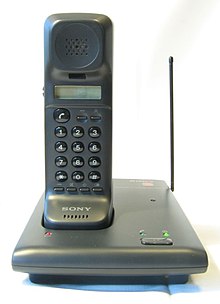Cordless phone
A cordless telephone is a landline telephone that is connected via radio connection-oriented to a base station in close proximity and thus enables the subscriber to move freely within this radius during the call. The invention goes back to George Sweigert . Cordless telephones are mainly used in the home.
Cordless telephone corresponds to the English term cordless telephone , abbreviated to CT. Under this name, two standardized techniques were initially brought onto the market, CT1 and CT2. CT1 defines a cordless telephone with 80 analog duplex channels, whereby the channels have a frequency spacing of 25 kHz. CT2 has 40 duplex channels and works with a digital transmission method.
CT1 and CT2 have now been replaced by the DECT standard.
construction

A cordless telephone usually consists of the handset, i.e. the telephone receiver, and a base station that is connected to the landline network via a telephone socket . The base station usually also serves as a charging station through which the handset's battery is charged. But there are also devices in which the base station and charging station are separate. A combination of handset and charger is often sold, which can then be operated in conjunction with an existing base station or a DECT-capable desk phone. Also combinations of desk and mobile phone plus charger are common. There are also versions in which the base station is combined with other functional devices such as a radio receiver or an alarm clock.
Transmission method
CT1 to CT3
In 1984, CT1 was adopted as the first European standard of its kind by the CEPT and recognized by eleven European countries. The handset transmits on 914–915 MHz ( uplink ), the base station on 959–960 MHz ( downlink ). For each frequency range 40 channels were defined at a distance of 25 kHz. However, since this range is also in the GSM band, GSM channels 120 to 124 could not be used. On January 1, 1998, this frequency range was completely transferred to GSM. Since this date, CT1 devices are no longer approved in Germany. In Austria, the operating license for CT1 devices ended in 2005.
In Belgium, Germany, Luxembourg and Switzerland a further 80 channels in the frequency range 885–887 MHz ( uplink ) and 930–932 MHz ( downlink ) were released. This extension is called CT1 + .
The CT2 digital transmission method was first standardized in Great Britain in 1985 as MPT1375 and was later adopted by many other countries. It uses the frequency range 864–868 MHz.
The transmission method CT3 gained no practical importance since it was replaced by DECT.
The general allocation of frequencies for the cordless telephone systems CT1 + and CT2 ended in Germany on December 31, 2008. Since this date, the operation of such devices is no longer permitted in Germany and is an administrative offense that can lead to the payment of a fine. At the beginning of November 2008, however, the federal government weakened its response to a corresponding minor request : Continued operation is also tolerated in Germany as long as there is no interference from the CT1 + device.
DECT
DECT has been the current standard for cordless telephones since 1992 as the successor to the CT1 and CT2 processes. With DECT-GAP , devices from different manufacturers can also be used on the same base station.
In Europe, DECT uses the frequency range 1880–1900 MHz. Since other frequency ranges are used for DECT devices in non-European countries, for example the USA, these devices may not be used in Europe and vice versa.
Bluetooth
With the Cordless Telephony Profile (CTP) , a technical standard for cordless telephones based on Bluetooth is available, but it was not able to establish itself. In the years 2003-2005 only a few prototypes and end devices were produced (e.g. Olympia CDP-24 201 ).
WIRELESS INTERNET ACCESS
Wireless WLAN telephones are increasingly available on the market . These can be used for IP telephony or at base stations such as B. AVM Fritz! Boxes , can be connected as a handset . With the appropriate apps , smartphones can also be used as WLAN handsets.
Web links
Individual evidence
- ↑ Older cell phones soon to be banned heise.de, May 12, 2008.
- ↑ Federal Network Agency warns against using old cordless telephones after 2008 heise.de, May 27, 2008.
- ↑ Answer of the Federal Government to the minor question from the MP Sylvia Kotting-Uhl . (PDF; 67 kB) German Bundestag, accessed November 30, 2008 .


